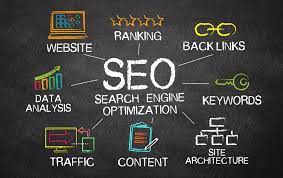SEO Site: Boost Your Online Visibility and Drive More Traffic
In today’s digital age, having a strong online presence is crucial for businesses and individuals alike. Whether you run an e-commerce store or a personal blog, being easily discoverable on search engines can make all the difference. This is where SEO (Search Engine Optimization) comes into play, and having an SEO-optimized website can significantly impact your online success.
What is an SEO site?
An SEO site is a website that has been strategically designed and developed to improve its visibility on search engine results pages (SERPs). It involves implementing various techniques and best practices to ensure that search engines understand the content of your site and rank it higher in relevant searches.
Why is an SEO site important?
Increased visibility: When your website ranks higher on search engine results, it becomes more visible to potential visitors. Studies show that most users don’t scroll past the first page of search results, making it essential to appear in those top positions.
More organic traffic: Organic traffic refers to visitors who find your website through unpaid search results. By optimizing your site for relevant keywords and providing valuable content, you can attract more organic traffic, resulting in higher conversion rates.
Better user experience: An SEO-optimized site not only focuses on search engine algorithms but also prioritizes user experience. By improving page load speed, mobile responsiveness, and overall usability, you create a positive experience for visitors, encouraging them to stay longer and explore more.
Competitive edge: In today’s competitive online landscape, having an SEO site gives you an edge over competitors who may not prioritize optimization. By outranking them in searches related to your industry or niche, you establish yourself as a credible authority.
How to create an SEO site:
Keyword research: Identify relevant keywords related to your business or content using keyword research tools. Incorporate these keywords naturally throughout your website’s pages, including titles, headings, meta descriptions, and content.
High-quality content: Create informative, engaging, and unique content that provides value to your target audience. Regularly update your site with fresh content to keep visitors coming back and search engines crawling.
On-page optimization: Optimize your website’s structure, URL structure, meta tags, image alt tags, and internal linking. Ensure that your site is easily navigable for both users and search engine crawlers.
Mobile optimization: With the increasing use of mobile devices for internet browsing, it’s crucial to have a mobile-friendly website. Responsive design ensures that your site adapts to different screen sizes and enhances the user experience.
Technical SEO: Pay attention to technical aspects such as XML sitemaps, robots.txt files, canonical tags, and website speed optimization. These factors help search engines crawl and index your site more effectively.
Backlinks: Build high-quality backlinks from reputable websites in your industry. Quality backlinks act as endorsements for your site’s credibility and authority in the eyes of search engines.
Analytics and monitoring: Track your website’s performance using analytics tools like Google Analytics. Monitor key metrics such as organic traffic, bounce rate, conversion rate, and keyword rankings to identify areas for improvement.
In conclusion, having an SEO-optimized website is essential for improving online visibility, attracting organic traffic, enhancing user experience, and staying ahead of competitors. By implementing effective SEO strategies and best practices, you can boost your website’s ranking on search engine results pages and drive more targeted traffic to achieve your online goals.
7 Common Questions About SEO for Your Website
- How can I SEO my own website?
- Is SEO for free?
- What is SEO for my website?
- Can you do SEO for free?
- Can I do SEO on my own website?
- What is SEO for website?
- How do I see SEO on a website?
How can I SEO my own website?
Optimizing your own website for SEO can be a rewarding and effective way to improve your online visibility. Here are some steps you can take to SEO your own website:
Keyword Research: Identify relevant keywords related to your website’s content and target audience. Use keyword research tools like Google Keyword Planner or SEMrush to discover popular search terms with moderate competition.
On-Page Optimization:
– Title Tags: Include your target keyword in the title tag of each page, making it concise, descriptive, and compelling.
– Meta Descriptions: Write unique and engaging meta descriptions that accurately summarize the content of each page. Include relevant keywords naturally.
– Headings: Use heading tags (H1, H2, H3, etc.) to structure your content logically. Incorporate keywords in headings when appropriate.
– URL Structure: Create clean and descriptive URLs that include relevant keywords instead of long strings of numbers or symbols.
– Image Optimization: Optimize image file names and alt tags with descriptive keywords to help search engines understand the context of the images.
Content Creation:
– High-Quality Content: Create original, informative, and engaging content that provides value to your target audience. Incorporate relevant keywords naturally within the content.
– Keyword Placement: Strategically incorporate keywords in headings, subheadings, paragraphs, and anchor text while maintaining readability and avoiding keyword stuffing.
– Regular Updates: Keep your website fresh by regularly adding new content or updating existing pages. This signals search engines that your site is active and relevant.
Site Structure:
– Navigation: Ensure intuitive navigation throughout your site so visitors can easily find what they’re looking for. Organize pages into logical categories and use internal linking to connect related content.
– Site Speed: Optimize page load speed by compressing images, minifying CSS/JavaScript files, utilizing caching techniques, and choosing a reliable hosting provider.
Mobile Optimization:
– Responsive Design: Ensure your website is mobile-friendly and adapts to different screen sizes. Responsive design improves user experience and helps with search engine rankings.
Backlinks:
– Quality Backlinks: Build high-quality backlinks from reputable websites in your industry. Focus on natural link-building strategies like guest blogging, content promotion, and networking with influencers.
– Social Media: Promote your content on social media platforms to increase visibility and encourage others to share and link back to your website.
Technical SEO:
– XML Sitemap: Create an XML sitemap that lists all the pages on your site to help search engines crawl and index your content more efficiently.
– Robots.txt: Use a robots.txt file to guide search engine crawlers on which pages to crawl or exclude from indexing.
– Website Security: Ensure your website has proper security measures in place, such as SSL certificates, to protect user data and gain trust from both visitors and search engines.
Analytics and Monitoring:
– Set up Google Analytics or other analytics tools to track important metrics like organic traffic, bounce rate, conversion rate, keyword rankings, and user behavior. Analyze the data regularly to identify areas for improvement.
Remember that SEO is an ongoing process, so continue monitoring your website’s performance, adapting strategies based on new trends or algorithm updates, and staying informed about best practices in the ever-evolving world of SEO.
Is SEO for free?
While there are many aspects of SEO that can be done for free, such as optimizing your website’s structure and content, it’s important to note that SEO is a long-term investment that often requires time, effort, and sometimes financial resources. Here are some points to consider:
- Organic SEO: Optimizing your website’s on-page elements, creating high-quality content, and building backlinks can be done without any direct cost. However, these activities require consistent effort and expertise to achieve desired results.
- Tools and resources: There are free tools available, like Google Analytics and Google Search Console, which provide valuable insights into your website’s performance and help you track key metrics. However, advanced SEO tools and services may come at a cost.
- Time and expertise: Implementing effective SEO strategies requires knowledge of best practices and staying up-to-date with search engine algorithm changes. It takes time to research keywords, create optimized content, analyze data, and make necessary adjustments.
- Paid advertising: While not directly related to organic SEO efforts, paid advertising (such as pay-per-click campaigns) can complement your SEO strategy by driving immediate traffic to your site. However, this involves budget allocation for ad spend.
Ultimately, the cost of SEO depends on various factors such as the complexity of your website, competition in your industry/niche, desired goals, and the extent to which you choose to invest in professional services or paid tools. It’s important to weigh the potential benefits against the costs involved in order to make informed decisions about allocating resources for SEO activities.
What is SEO for my website?
SEO, or Search Engine Optimization, refers to the practice of optimizing your website in order to improve its visibility and ranking on search engine results pages (SERPs). When someone searches for a specific keyword or phrase related to your website’s content, SEO helps search engines understand and recognize your site as relevant and valuable.
By implementing SEO techniques, you can increase the chances of your website appearing higher in search engine rankings, ultimately driving more organic (unpaid) traffic to your site. This is important because studies have shown that the majority of users tend to click on the top results displayed on SERPs.
SEO involves various strategies and best practices, including:
- Keyword Research: Identifying relevant keywords and phrases that people are searching for in relation to your website’s content. These keywords should be strategically incorporated into your website’s pages, including titles, headings, meta descriptions, and content.
- On-Page Optimization: Optimizing various elements on your web pages such as URL structure, meta tags (title tags and meta descriptions), heading tags (H1-H6), image alt tags, and internal linking. This ensures that search engines can easily crawl and understand the content of your site.
- Content Creation: Creating high-quality, informative, and engaging content that provides value to your target audience. Regularly updating your website with fresh content not only attracts visitors but also signals to search engines that your site is active and relevant.
- Technical SEO: Paying attention to technical aspects such as XML sitemaps, robots.txt files, canonical tags, website speed optimization, mobile responsiveness, and ensuring proper indexing by search engines.
- Backlink Building: Acquiring high-quality backlinks from reputable websites in your industry or niche. Backlinks act as endorsements for the credibility and authority of your website in the eyes of search engines.
- User Experience: Ensuring that your website is user-friendly with easy navigation, fast loading times, and a responsive design that adapts well to different devices and screen sizes.
- Analytics and Monitoring: Tracking your website’s performance using analytics tools like Google Analytics. Monitoring key metrics such as organic traffic, bounce rate, conversion rate, and keyword rankings helps identify areas for improvement and measure the effectiveness of your SEO efforts.
Implementing effective SEO strategies can help your website rank higher in search engine results, attract targeted organic traffic, increase visibility, and ultimately drive more conversions and achieve your online goals.
Can you do SEO for free?
Yes, it is possible to perform SEO activities for free. While there are paid tools and services available that can enhance your SEO efforts, there are also several free strategies and resources you can utilize to improve your website’s visibility. Here are some ways to do SEO for free:
- Keyword Research: Use free keyword research tools like Google Keyword Planner, Ubersuggest, or Answer the Public to identify relevant keywords for your content.
- On-Page Optimization: Optimize your website’s titles, headings, meta descriptions, and content by incorporating targeted keywords naturally. Ensure proper formatting, readability, and use of header tags.
- High-Quality Content: Create informative and engaging content that provides value to your audience. Regularly update your website with fresh content to attract visitors and search engine crawlers.
- Website Structure: Organize your website’s structure in a logical manner with clear navigation menus and internal linking. This helps both users and search engines understand the hierarchy of your site.
- Mobile Optimization: Ensure that your website is mobile-friendly by using a responsive design that adapts to different screen sizes. Google’s Mobile-Friendly Test tool can help you assess if your site meets mobile optimization standards.
- Technical SEO: Optimize technical aspects of your website such as XML sitemaps, robots.txt files, canonical tags, and page load speed. Tools like Google Search Console can assist in identifying and fixing technical issues.
- Backlinks: Focus on building high-quality backlinks from reputable websites in your industry or niche. Engage in guest blogging or participate in online communities where you can share valuable insights and earn backlinks naturally.
- Social Media Presence: Utilize social media platforms to promote your content and engage with your audience. Sharing links to your website on social media can drive traffic and potentially earn social signals that contribute to SEO.
- Local SEO: If you have a local business, optimize your website for local searches by including location-specific keywords and creating a Google My Business profile.
- Analytics and Monitoring: Set up Google Analytics to track your website’s performance. Monitor key metrics like organic traffic, bounce rate, and conversion rate to identify areas for improvement.
While investing in paid SEO tools and services can provide additional insights and automation, following these free strategies can still make a significant impact on your website’s visibility and search engine rankings.
Can I do SEO on my own website?
Yes, you can definitely do SEO on your own website. While hiring professional SEO services can be beneficial, especially for complex or competitive industries, there are several steps you can take to improve your website’s visibility without external assistance. Here are some key aspects of SEO that you can work on:
- Keyword Research: Identify relevant keywords and phrases that your target audience is likely to search for. Use keyword research tools to find popular and less competitive keywords that align with your content.
- On-Page Optimization: Optimize your website’s pages by incorporating target keywords into titles, headings, meta descriptions, and content. Ensure that your content is well-structured, easily readable, and provides value to visitors.
- Content Creation: Regularly create high-quality and engaging content that caters to the interests and needs of your target audience. Publish blog posts, articles, videos, or any other format that suits your niche.
- Technical SEO: Pay attention to technical aspects such as website speed optimization, mobile responsiveness, XML sitemaps, robots.txt file configuration, and proper URL structure.
- Link Building: Focus on building quality backlinks from reputable websites in your industry or niche. Guest blogging, creating shareable content, participating in online communities or forums related to your field are effective ways to acquire backlinks.
- Social Media Presence: Establish a strong presence on social media platforms relevant to your business or industry. Engage with your audience regularly by sharing valuable content and responding to comments or messages.
- User Experience: Ensure that your website is user-friendly and easy to navigate across different devices. Improve page load speed, optimize images for faster loading times, and make sure the site layout is intuitive for visitors.
- Analytics & Monitoring: Use tools like Google Analytics to track important metrics such as organic traffic, bounce rate, conversion rate, keyword rankings, and user behavior on your site. Analyze the data to identify areas for improvement and adjust your SEO strategy accordingly.
Remember that SEO is an ongoing process, and it takes time to see significant results. Stay updated with the latest SEO trends and algorithm changes to continuously optimize your website and stay ahead of the competition.
What is SEO for website?
SEO, or Search Engine Optimization, is the practice of optimizing a website to improve its visibility and ranking on search engine results pages (SERPs). It involves implementing various techniques and strategies to make a website more attractive to search engines, ultimately driving organic (unpaid) traffic to the site.
The goal of SEO is to ensure that search engines understand the content and relevance of a website, making it more likely to appear in relevant searches. By optimizing factors such as keywords, meta tags, site structure, user experience, and backlinks, SEO aims to improve a website’s chances of ranking higher in search results.
When a website ranks higher on SERPs, it becomes more visible to potential visitors. Since most users tend to click on the top results displayed by search engines, being among those top positions can significantly increase organic traffic. With increased visibility and targeted traffic, businesses can attract more potential customers or readers and achieve their online goals.
SEO for websites involves both on-page optimization and off-page optimization. On-page optimization focuses on optimizing elements within the website itself, such as content quality, keyword usage, meta descriptions, headings, URL structure, internal linking, and mobile responsiveness. Off-page optimization involves building high-quality backlinks from other reputable websites in order to establish credibility and authority in the eyes of search engines.
It’s important to note that SEO is an ongoing process rather than a one-time task. Search engine algorithms are constantly evolving, so maintaining an optimized website requires staying up-to-date with industry trends and best practices. Regular monitoring of key metrics like organic traffic and keyword rankings helps identify areas for improvement and allows adjustments to be made accordingly.
Overall, SEO for websites is essential for improving online visibility, attracting organic traffic, enhancing user experience, and ultimately achieving better business outcomes through increased conversions or engagement.
How do I see SEO on a website?
To see the SEO elements on a website, you can follow these steps:
- Page Titles: Check the titles displayed at the top of each page in your browser’s tab. These titles should accurately describe the content of each page and include relevant keywords.
- Meta Descriptions: Look for meta descriptions, which are short summaries of a webpage’s content that appear below the page title in search engine results. Meta descriptions should be informative, engaging, and optimized with keywords.
- URL Structure: Examine the URLs of different pages on the website. A well-optimized URL structure is concise, descriptive, and includes relevant keywords.
- Heading Tags: Scan through the headings (H1, H2, H3, etc.) used in the content of each page. Heading tags help search engines understand the hierarchy and structure of your content. Ensure that headings are properly formatted and contain relevant keywords.
- Content Optimization: Read through the content on various pages to see if it is well-written, informative, and includes relevant keywords naturally within the text. Look for high-quality images with optimized alt tags as well.
- Internal Linking: Check if there are internal links within the website’s content that connect related pages together. Internal linking helps search engines navigate your site and improves user experience by allowing visitors to easily find relevant information.
- Mobile-Friendliness: Visit the website on different devices (desktop, mobile phone, tablet) to assess its responsiveness and mobile-friendliness. A mobile-optimized website is crucial as more users access websites using mobile devices.
- Page Load Speed: Use online tools like Google PageSpeed Insights or GTmetrix to evaluate how quickly each page loads. Fast-loading pages contribute to a positive user experience and can improve search engine rankings.
- Structured Data Markup: Check if structured data markup (such as Schema.org) is implemented on key pages to provide additional context to search engines. Structured data helps search engines understand and display your content more effectively.
- Backlinks: Analyze the website’s backlink profile using tools like Moz or Ahrefs. Backlinks are incoming links from other websites, and a healthy backlink profile can improve your website’s authority and search engine rankings.
Remember, these steps provide a general overview of how to assess SEO elements on a website. For a more comprehensive analysis, you may consider using specialized SEO tools or consulting with an SEO professional.




